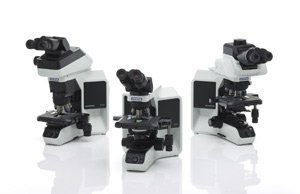Apr 5 2010
Olympus has unveiled its BX3® line of upright clinical and research microscopes with exclusive ergonomic and imaging features that provide unprecedented comfort, ease of use and accuracy. The all-new BX3 microscope lineup will deliver outstanding optical performance, value, reliability and eco-friendly operation.

Newly introduced are the BX43 System Microscope for clinical laboratory applications, the BX46 Clinical Microscope with exceptionally ergonomic design and fast observation, and the BX53 System Microscope for research/clinical applications. All three systems employ the company’s proprietary UIS2 optics, which deliver ultra-sharp, bright images and are manufactured from lead-free glass. The new systems succeed the immensely successful Olympus BX2 microscopes, which are among the most popular clinical microscopes in US laboratories.
“Customers who have enjoyed Olympus microscopes’ legendary optical performance, longevity and comfortable operation will recognize all the things they love in the new systems,” said Edward Lachica, Ph.D., Director of Product Marketing, Scientific Equipment Group, Olympus America Inc. “They’ll also benefit from the intelligent integration of new features that make the accuracy, efficiency and ergonomics even better than before.”
Additional advancements in the design of the BX3 series allow users to record and share microscope magnification and setting information automatically for comparing, measuring and scaling images. There is even a handy exposure button that makes it possible for researchers to capture digital images without taking their hands off the microscope. Another new option is a tilting trinocular observation tube that provides comfortable, efficient operation when capturing photomicrographs.
The BX43 and BX46 are designed for efficiency and comfort in clinical applications. Their performance and value are enhanced through environmentally-conscious features including a bright LED lamp that offers halogen-like color fidelity, uses less energy and lasts approximately 20,000 hours. A Light Intensity Manager eliminates the need to make manual adjustments when changing magnifications. Users can select either left- or right-handed microscope operation for maximum flexibility.
New to both instruments is the world’s first optional tilting, telescoping and lifting observation tube, which easily allows users to adjust the height, front-to-back position and tilt angle of the eyepieces independently for the ultimate in comfortable observation.
The BX46 features the lowest stage height available – just three inches above the tabletop – for the ultimate in stress-free operation with reduced fatigue. The fixed stage design of the BX46 provides exceptional stability and accuracy in specimen positioning.
The BX53 research/clinical system offers new fluorescence optics and filters, including improved hard-coating technology and a unique fly’s eye array that delivers higher-quality images by providing more even illumination. It offers a unique motion sensor that detects when the user steps away from the instrument, automatically turning off the lamp after approximately 30 minutes, thus saving energy and providing longer lamp life. Both the BX43 and BX53 offer an optional new condenser that accommodates magnifications from 2x to 100x without requiring a swing-top lens.